For years, Hunza was my comfort zone. Every time I planned a trip up north, I’d find myself back in Karimabad, sipping chai with a view of Rakaposhi, convincing myself that I’d get to Skardu someday.
That day finally came—on two wheels.
Skardu was a stop on my broader journey through northern Pakistan, and taking the long way there turned out to be the best way to see it. The further I rode, the more the landscape shifted—lush green valleys gave way to jagged cliffs, high-altitude deserts, and rivers carving their way through rocky terrain. The change wasn’t subtle; it was stark, almost otherworldly.
Where Hunza feels welcoming and familiar, Skardu feels remote and untamed. It’s the kind of place that doesn’t soften itself for visitors—you just have to meet it on its own terms. If you’re looking for things to do in Skardu, expect a mix of dramatic landscapes, centuries-old forts, and places so wild they don’t seem real.
About Skardu: The Lay of the Land
Skardu is gateway to some of the most extreme landscapes in the world.
Located in Gilgit-Baltistan, Skardu sits in the Baltistan region, which has its own distinct culture, language, and history. Unlike Hunza, which has a mix of Wakhi and Burushaski influences, Skardu’s roots are deeply tied to Tibetan and Balti heritage. You’ll see it in the architecture, the food, and even the way people dress.
The geography here is dramatic. Skardu Valley is flanked by the Karakoram Range, home to some of the world’s highest peaks, including K2. But what makes it even more unique is the diverse terrain. In a single day, you could be:
- Standing on a cold desert with sand dunes at 7,500 feet
- Boating on turquoise alpine lakes
- Driving through Martian-like rock formations
- Climbing up ancient forts that overlook the mighty Indus River
And that’s just scratching the surface.
How to Get to Skardu
By Air: The quickest and most convenient way to reach Skardu is by air. Pakistan International Airlines (PIA) operates flights from Islamabad to Skardu. The flight is about 45 minutes long and offers stunning aerial views of the Karakoram and Himalayan ranges. Do keep in mind that flights are subject to weather conditions, so they can be a bit unpredictable.
By Road: If you’re up for it, you can drive from Islamabad to Skardu by road. The journey is around 20-22 hours long, covering approximately 630 kilometers. The drive is nothing short of spectacular, with breathtaking scenery along the Karakoram Highway. You can either hire a private car or take a bus service. NATCO (Northern Areas Transport Corporation) offers regular bus services from Islamabad to Skardu.
If you’re looking for an itinerary that covers both Hunza and Skardu, read my complete Northern Pakistan Guide.
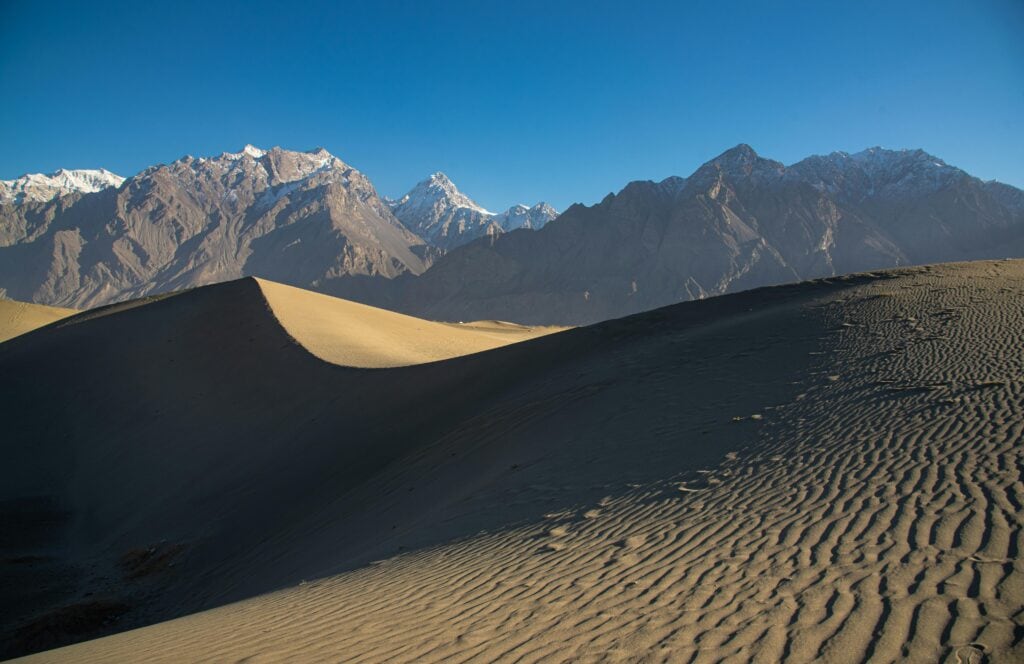
Musafir in Transit contains affiliate links and is a member of the Amazon Services LLC Associates Program. If you book through these links I may make a small commission at zero cost to you. It helps me pay for the upkeep of this blog. Thank you! See the Disclosure Policy for more info.
Best Time to Visit Skardu
Skip winter. Seriously. Unless you have a thing for freezing indoors, don’t do it. Infrastructure isn’t great, heating is a struggle, and road closures are common. I’m past the stage where I’d “tough it out” for the sake of adventure—if I don’t have to be cold, I won’t be.
If you’re set on a winter trip up north, go skiing instead—Naltar or Malam Jabba are better equipped for it. Skardu in winter? Just a lot of shivering, unpredictable flights, and places shutting down.
For hiking and exploring, summer (June–September) is perfect—the trails are open, the lakes are at their bluest, and you won’t be stuck indoors waiting for the weather to clear. If you want fewer crowds and stunning landscapes, spring (April–May) and autumn (October) are solid alternatives, with wildflowers or golden leaves making everything look unreal.
About This Skardu Pakistan Guide
Instead of just listing every possible place, this guide is structured around a mix of must-see spots, day trips, and more remote adventures—so you can plan based on the time and effort you want to put in.
Closest spots in Skardu town – These are places you can visit without needing a long drive, perfect if you’re short on time.
A little outside Skardu – A bit of a journey, but still doable as day trips.
The remote gems – These require more planning and effort, but they’re so worth it.
This way, you can pick and choose based on how many days you have. If you’re just passing through, you’ll hit the essentials. If you have time to spare, you’ll get a mix of iconic spots and lesser-known treasures.
1. Shigar Fort
Distance from Skardu: 32 km
Shigar Fort doesn’t feel like a fort. At least, not in the way you’d imagine—no crumbling walls or eerie ruins. Instead, it’s surprisingly well-preserved and feels more like a royal residence frozen in time.
It is set in the heart of Shigar Valley, a key gateway to the Karakoram Range. Anyone heading toward K2, Broad Peak, or the Baltoro Glacier has to pass through here.
The fort, built in the 17th century by the Raja of Shigar, has been beautifully restored by the Aga Khan Trust. You can stay overnight in the boutique hotel or just wander through its carved wooden balconies and quiet courtyards.
If you follow the little paths that wind around the fort, you’ll stumble upon Shigar’s ancient village. Unlike Skardu, which feels more developed, Shigar is where you’ll see the old Balti way of life still thriving—stone houses with tiny wooden doors, women drying apricots on their rooftops, kids running barefoot through narrow alleys. It’s worth taking a slow walk through the village, stopping at one of the tiny roadside teashops, and just watching life unfold.For the best experience, visit around sunset and take a short hike to the Shigar viewpoint. It’s unmarked, but locals will guide you—it’s worth it for the view of the fort, the river, and the mountains stretching into the horizon.
2. Kharpocho Fort (Skardu Fort)
Distance from Skardu: 2 km
Kharpocho Fort sits on a rocky hill overlooking Skardu, and getting there means a steep, zigzagging climb. It’s not a long hike, but the loose gravel makes it tricky. Wear good shoes, bring water, and expect a bit of a workout.
Built in the 16th century by the Maqpon rulers, the fort itself is more of a weathered stone structure than an architectural marvel. But its location makes it worth the effort. Right below the fort is Skardu’s organic forest, a rare patch of green in an otherwise rocky landscape. In spring (April–May), apricot and walnut trees bloom here, adding unexpected color. The best part? Take the unmarked trail behind the fort, and you’ll reach a hidden cliffside viewpoint. From here, you get an open view of Skardu town, the Indus River, and the mountains beyond—without the usual crowd. Just be careful on the descent—loose stones make slipping easy.
3. Khaplu Palace
Distance from Skardu: 103km
I’ve always wanted to stay at Khaplu Palace, but it’s never quite fit my budget. That doesn’t mean it’s not worth a visit—this 19th-century palace, once home to the Raja of Khaplu, is one of the most well-preserved examples of Balti and Tibetan architecture.
Unlike Shigar Fort, which feels more polished, Khaplu Palace has a quieter, more lived-in feel. The intricate wooden balconies, carved doors, and sunlit courtyards give a glimpse into what royal life might have been like. There’s also a small museum inside, with artifacts and photographs that tell the story of the region’s rulers.
Even if you’re just passing through, grab a chai at the Serena-run café inside the palace. It’s the closest you’ll get to feeling like Balti royalty—at least without booking a room.
4. Safaranga Cold Dessert
Distance from Skardu: 15 km
A desert at 7,500 feet? Only in Shigar. The Sarfaranga Cold Desert is a mix of white sand dunes, jagged peaks, and the winding Shigar River, all coexisting in a way that shouldn’t make sense—but somehow does.
The first time I visited was during the Sarfaranga Jeep Rally, which meant I found myself surrounded by 4,000 men and a whole lot of revving engines—not exactly my scene. But outside of rally season, the desert is a quiet, otherworldly landscape, perfect for jeep safaris, quad biking, and sandboarding. Sunset is the best time to visit, when the dunes take on a golden glow.
Geologically speaking, the desert was formed by wind erosion and glacial deposits over centuries. Unlike the vast deserts of Sindh or Balochistan, this one exists because of the high-altitude wind patterns and the unique Karakoram climate.
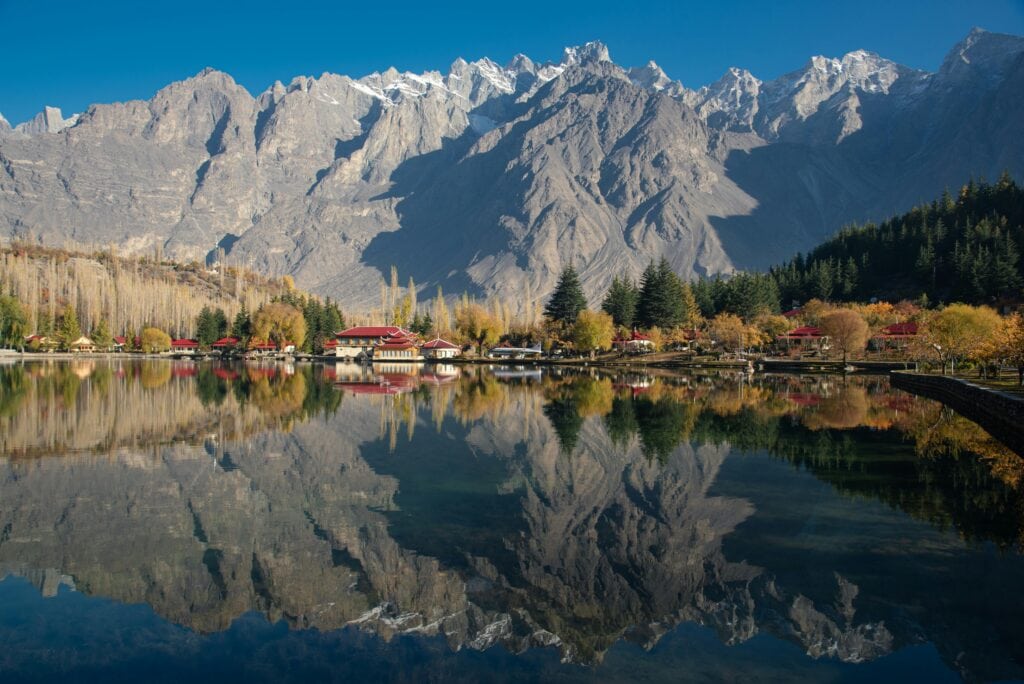
5. Lower and Upper Kachura Lakes
Distance from Skardu: 35 km
If you’ve seen one photo of Skardu, it’s probably Lower Kachura Lake, better known as Shangrila Lake. The lake itself is beautiful, but what makes it famous is Shangrila Resort, with its red-roofed cottages and an old plane sitting in the middle of the property. The plane—an actual crash-landed aircraft—was turned into a restaurant, making it one of the most photographed spots in Skardu.But Upper Kachura Lake is where you should be heading. A 20-30 minute walk from the lower lake, it’s quieter, less commercialized, and still has that untouched, wild feel. The water is crystal-clear, reflecting the mountains around it, and if you’re up for it, you can even take a quick swim—though brace yourself, the water is freezing.
Katpana Desert
Distance from Skardu: 15 km
Katpana and Sarfaranga are often confused, but they offer different experiences. Katpana is closer to Skardu and easier to reach, with smoother, softer dunes that make it ideal for a quiet walk. Sarfaranga, on the other hand, is harsher and more rugged, with larger dunes and a more dramatic landscape. It’s also where the Jeep Rally takes place, so if you’re looking for quad biking or off-roading, that’s the better choice.
The biggest difference? Katpana sees snowfall in winter, turning it into a surreal mix of white sand and snow-covered dunes—something you won’t find at Sarfaranga. If you visit at night, Katpana is also one of the best spots in Skardu for stargazing, thanks to the clear mountain skies.
6. Deosai National Park and Sheosar Lake
Distance from Skardu: 35 km
At 4,100 meters, Deosai is the world’s second-highest plateau—an endless stretch of rolling plains, wildflowers, and complete silence, apart from the wind and the occasional marmot. There’s nothing quite like it in Pakistan. I’ve been twice and would 100% go again.
The highlight? Sheosar Lake. On a clear day, you can see Nanga Parbat in the distance, its peak looming over the horizon. The best camping spots are near Sheosar or Bara Pani, where other travelers gather—wandering too far out means a higher chance of running into a Himalayan brown bear.
Deosai is only accessible in summer.
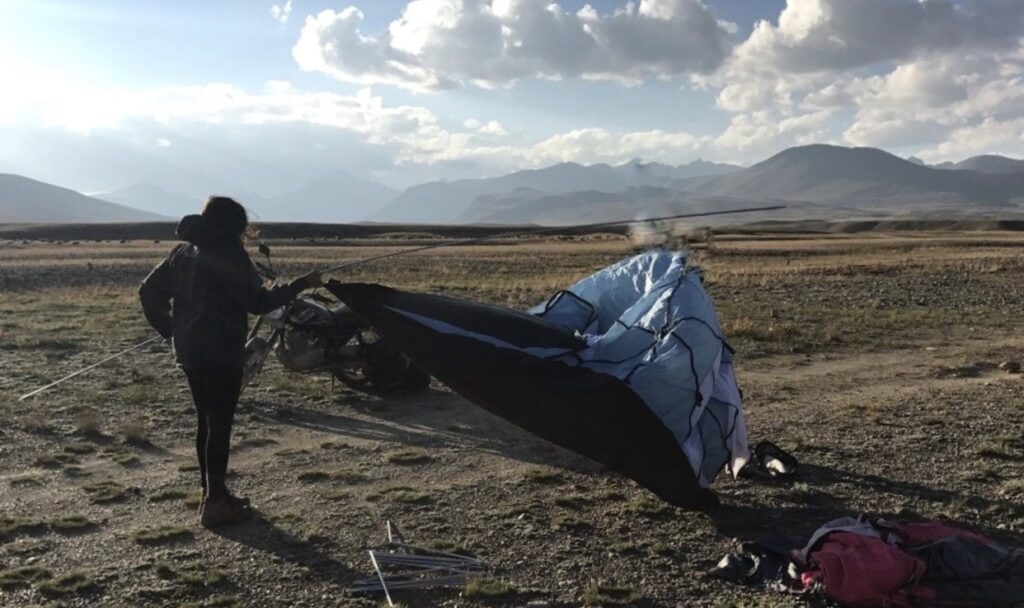
K2 Museum
Distance from Skardu: 4km
The K2 Museum isn’t flashy, but it’s one of the few places in Skardu that truly captures the region’s mountaineering history. Housed in a dome-shaped tent, designed to resemble the base camps used by climbers, it was established with help from Italian mountaineers to honor the 1954 Italian expedition that first summited K2.
Inside, you’ll find climbing gear from past expeditions, including battered ice axes, frostbitten gloves, and oxygen tanks that have been to the summit. There are detailed route maps, old photographs, and personal journals from climbers who risked their lives on the mountain. What makes it interesting is the section dedicated to Pakistani climbers, highlighting the Balti high-altitude porters and guides who’ve been essential to nearly every major ascent.
K2 doesn’t see anywhere near the traffic of Everest—it’s steeper, deadlier, and far less forgiving. This museum gives you a glimpse into why climbers still attempt it despite the odds. Even if you’re not into mountaineering, standing in front of gear that survived some of K2’s worst storms puts things into perspective.
Manthoka Waterfalls
Distance from Skardu: 80 km
At 55m, Manthoka Waterfall is impressive, but is it mind-blowing? Not really. If you’re already in Skardu, it’s worth the stop, but don’t expect some untouched natural wonder. The area has been developed with small food stalls and picnic spots, which takes away from the wild beauty you might be hoping for.
That said, the drive is scenic, and the sound of the rushing water makes for a refreshing break from Skardu’s dry landscapes. If you’ve got the time, grab a chai, stretch your legs, and enjoy the mist from the falls. But if you’re short on time, you’re not missing out on a must-see spot.
Sadpara Lake
Distance from Skardu: 8 km
Sadpara Lake is one of the easier places to visit near Skardu, and while it’s often overshadowed by Deosai and the Kachura Lakes, it has its own quiet charm. The dusty brown mountains surrounding the deep blue water give it a stark, almost eerie beauty.
The lake also supplies water to Skardu, so it’s more functional than touristy. I didn’t spend too much time here, but if you’re looking for a peaceful place to sit and take in the landscape, it’s worth a short visit.
Manthal Buddha Rock
Distance from Skardu: 3 km
Tucked away just outside Skardu, Manthal Buddha Rock is one of the last reminders of the region’s Buddhist past. It’s an 8th-century carving, weathered but still detailed enough to make out the figure of Buddha surrounded by smaller figures.
I’ll be honest—it’s not the most exciting place if ancient rock carvings aren’t your thing. You’ll stop, look at it, take a picture, and be done in five minutes. But historically, it’s fascinating. Before Islam reached Baltistan, this area had strong Buddhist influences, and this rock is one of the few pieces of evidence left. If you’re into history, it’s a cool little detour. If not, you won’t feel like you missed out.
Masrur Rock
Distance from Skardu: 7 km
Masrur Rock is another ancient rock carving, but between this and Manthal Buddha Rock, I’d pick Manthal if you only have time for one. The carvings here are less distinct, and unless you have a serious interest in ancient inscriptions, it won’t hold your attention for long.
Back when I visited, I wasn’t that interested—I come to Skardu for the landscapes, not the history. Maybe I’d appreciate it more now, but if you’re short on time, I wouldn’t call this a must-visit. If you’re already in the area, check it out. If not, you’re better off heading to the mountains.
Saling
Distance from Skardu: 58 km
I first passed through Saling on my way to K6/K7 Base Camp, and while I didn’t plan to stay long, it stuck with me. The village is small, tucked between green pastures and traditional Balti houses, with a suspension bridge stretching across the Shyok River. It’s the kind of place where nothing much happens—and that’s the beauty of it.
If you’re already heading towards Hushe Valley or K6/K7, Saling makes for a great stop. The locals are welcoming, and if you slow down, you’ll notice farmers tending their fields, kids herding goats, and birds you won’t see anywhere else in Skardu. It’s not a destination in itself, but if you like places that feel untouched, it’s worth a visit.
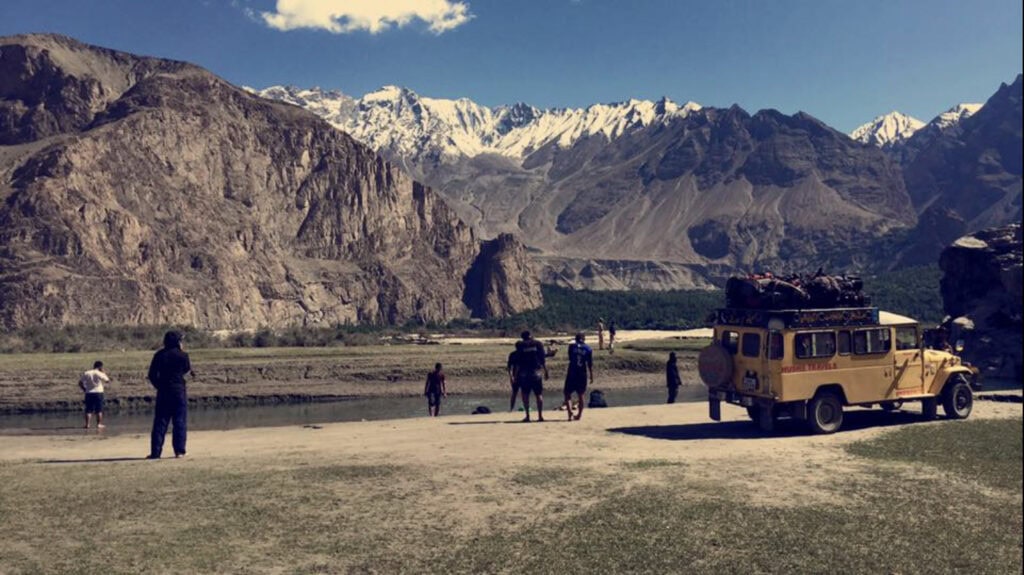
Basho Valley
Distance from Skardu: 50 km
I haven’t personally been to Basho Valley, but everyone I know who has raves about it. It’s a quieter alternative to Deosai, with meadows, pine forests, and rivers weaving through the valley. The drive up is a bit rough, but once you get there, you’re surrounded by untouched alpine scenery.
People usually visit for camping, short hikes, and photography, though even a day trip is worth it if you’re looking for a scenic escape from Skardu’s drier landscapes. If you’ve been to Minapin or Fairy Meadows, think of Basho as their underrated cousin—just as beautiful, with fewer tourists.
Moses Peak
Distance from Skardu: 35km
Moses Peak is not an easy hike, but it’s doable in a day if you’re in decent shape. The trek starts from Satpara and climbs steadily, with some steep sections towards the top. The biggest challenge? The altitude—you’ll feel the thinner air as you gain elevation.
The reward, though, is worth it. From the summit, you get a 360-degree view of Skardu, Satpara Lake, and the surrounding Karakoram peaks. The best time to attempt it is early morning—not just for the cooler temperatures, but because clouds tend to roll in later in the day, blocking the views.
Bring proper hiking shoes, warm layers, and at least 2 liters of water. It’s a trek that won’t destroy you, but you’ll definitely feel it in your legs the next day
Nansoq Organic Village – Soq Valley
Distance from Skardu: 3km
Nansoq isn’t just another village—it’s one of Pakistan’s first organic farming communities, where everything is grown, harvested, and consumed sustainably. It’s tucked away in Soq Valley, just outside Skardu, and while the trek there is short, it feels like stepping into a different world.
There are no modern developments, no rush, no noise—just simple Balti homes, fields full of vegetables, and locals who actually seem happy to be living off the land. If you’re lucky, you might even get to try fresh apricots or homemade butter straight from the source.
The best way to experience Nansoq? Walk through it slowly, talk to the people, and take in how different life is when it revolves around the land.
Skardu Bazar and What to Buy in Skardu
If you’re looking for a detailed shopping guide, I’m not the person to ask. I don’t go to Skardu to shop, but if you do find yourself in Skardu Bazaar, here’s what to expect:
It’s chaotic, dusty, and full of life. The main street is lined with small shops selling everything from hiking gear to dried apricots. If you want a souvenir, your best bet is handwoven Balti carpets, traditional caps, or gemstones—though unless you know your stones, you’re probably getting ripped off. The dried fruit here is legit though, so stock up before heading back.
If you’re hungry, you’ll find street stalls selling Balti-style momos and salty butter tea. The momo joints are hit or miss, but if you see a place packed with locals, that’s your spot.
Is it a must-visit? Not really. But if you need supplies, a snack, or just want to people-watch, it’s a good place to kill some time.
Chaqqan Mosque
Distance from Skardu: 103km
I haven’t been to Chaqqan Mosque, but it’s one of the oldest in Skardu, dating back about 400 years. It’s a simple but beautifully preserved structure made of stone and wood, reflecting traditional Balti-Islamic architecture.
What makes it stand out is its intricate wood carvings and hand-painted calligraphy, showcasing the craftsmanship of that time. Unlike the grand mosques of Lahore or Islamabad, this one feels quieter, more understated, and deeply connected to the local community. It’s still an active place of worship, so if you visit, be respectful of prayer times.
Would I go out of my way to see it? Probably not. But if you’re into history or architecture, it might be worth the stop.
Hushe Valley
Distance from Skardu: 140 km
We mentioned Saling earlier, and if you’re heading further into the mountains, Hushe Valley is where you’re going. This is Baltistan’s true mountaineering hub—a jumping-off point for expeditions to Masherbrum, K7, Laila Peak, and even K2 via the Gondogoro La trek.
Unlike some of the touristy valleys near Skardu, Hushe still feels remote and rugged. The roads are rough, the villages are simple, and the mountains? Absolutely massive. If you’re into trekking, this is one of the best places to start—whether it’s a short hike to Honbrok or something serious like Spantik Base Camp.
If you’re not trekking, is it worth the journey? Only if you truly love remote mountain landscapes. Otherwise, the 8-hour drive from Skardu might feel like a bit much.
Rama Lake
Distance from Skardu: 138 km
Rama Lake wasn’t even on my itinerary—I only ended up here because I had extra days to kill. Turns out, it was one of the best surprises of my trip.
The lake sits at 3,353 meters, surrounded by forests and alpine meadows, with a clear view of Nanga Parbat on a good day. At the time, there was a PTDC motel nearby—basic but convenient. I believe it’s shut down now, so if you’re staying overnight, you’ll need to find another option.
The trek up is easy, more of a nature walk than a serious hike, and the scenery changes from dense pine forest to open meadows. If you’re already heading towards Astore, Rama Lake is 100% worth the stop.
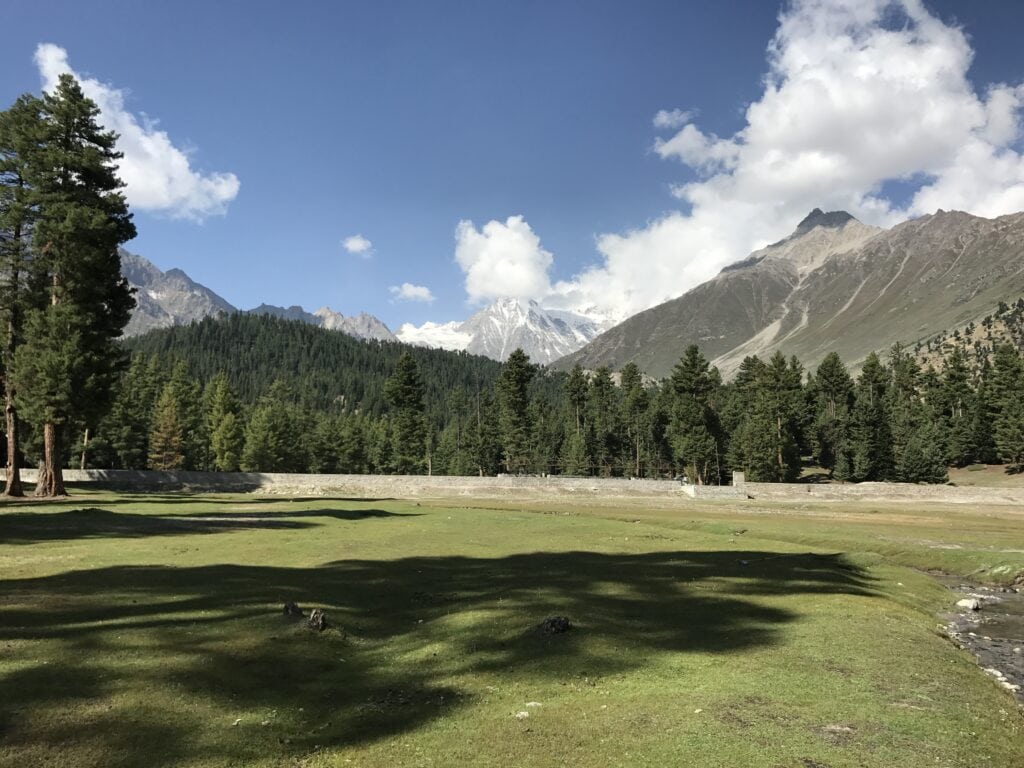
Mosque Sofia Noorbaksia Gharbonchong
Distance from Skardu: 2 km
I haven’t been to Mosque Sofia Noorbaksia Gharbonchong, but let’s be real—you’re probably not coming to Skardu for the mosques. That said, this one stands out because of its connection to the Noorbakshia Sufi order, which has a strong presence in Baltistan.
Architecturally, it’s different from the mosques you’d see in other parts of Pakistan—simpler, with more Tibetan and Persian influences. It’s said to be a quiet, meditative space, and if you’re interested in the spiritual traditions of the region, it could be an interesting stop.
Would I personally go out of my way for it? Probably not. But if you’re already in Skardu and have time, why not?
Where To Stay In Skardu
Skardu offers a range of accommodations to suit different budgets. Here are some of my recommendations:
Luxury | Serena Shigar Fort. A unique and luxurious experience in a restored fort with modern amenities and breathtaking views.
Mid-range | Baltistan Fort Skardu. Centrally located
Practical Tips for Visiting Skardu
A few things to keep in mind before heading to Skardu—because the mountains don’t care if you’re unprepared.
Packing: Skardu’s weather is unpredictable. You’ll get warm sunny days, freezing nights, and the occasional surprise storm—sometimes all in one trip. Layers are your best bet. Good shoes are a must.
Altitude & Health: Skardu sits way higher than you’re used to, and altitude sickness is real. Stay hydrated, take it easy on your first day, and if you know you struggle with altitude, bring meds.
Wildlife: If you’re camping in Deosai, keep your food stored properly unless you want an unexpected Himalayan brown bear encounter.
Connectivity: Internet is hit or miss. Zong and Telenor work best, but even then, don’t expect reliable service. Download offline maps before you get here, and if you need Wi-Fi, mentally prepare for slow speeds.
Language: Urdu is widely spoken, but learning a few Balti phrases goes a long way. English is understood in most tourist areas.
Respecting Culture: Dress modestly, especially in villages and religious sites. And if you’re about to take a photo of someone, ask first—it’s just basic decency.
Safety in Pakistan: If you’re wondering whether Pakistan is safe for travel, the short answer is yes—but with common sense. Skardu is one of the safest places in the country, and locals are incredibly welcoming. That said, it’s always good to stay aware of your surroundings, especially when traveling solo.
Tipping: Not mandatory, but if someone goes out of their way for you, a small tip is always appreciated.
That’s about it—Skardu is incredible, just don’t show up unprepared.
Ready to Explore Skardu?
Skardu isn’t the kind of place you visit once and move on—it’s the kind of place that pulls you back. Whether it’s hiking through wide-open landscapes, stumbling across centuries-old forts, or just sitting by a lake doing absolutely nothing, it stays with you long after you leave.
If you’ve made it this far, you’re probably planning a trip—or at least considering it. What’s on your list? Drop a comment and let me know what you’re most excited about. If you’ve already been, what spot lived up to the hype—and what didn’t?
For more no-nonsense travel guides, check out Hunza travel guide for first time travellers.
Related Posts
- A Series of Unfortunate Events: Public Transport Horror Story in Pakistan
- Journey Through Pakistan’s North – Deosai Plains, Minimarg and Nanga Parbat base camp
- Beyond Fairy Meadows: Nanga Parbat Base Camp Rupal Face Guide
- Skiing in Pakistan: A Local’s Guide to Hitting The Slopes
- Motorcycle Diaries
- Visa Free Countries on a Pakistani Passport
